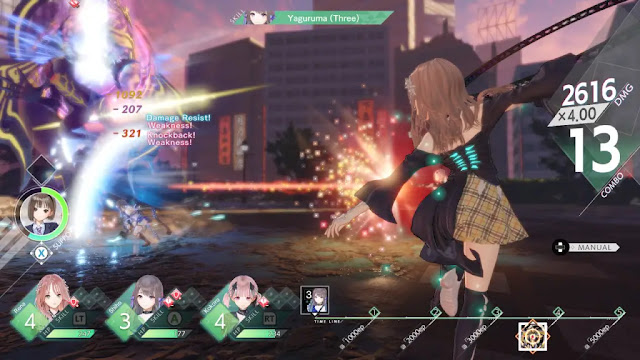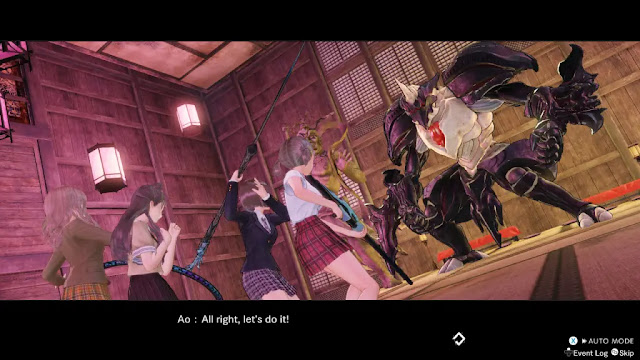Blue Reflection: Second Light by developer GUST and publisher Koei Tecmo America—Sony PlayStation 4 review written by Pierre-Yves with a copy provided by the publisher.
Estimated reading time: 8 minutes
Following on the back of its 2017 release, Gust and Tecmo Koei are back with the next entry into their now Blue Reflection series. Taking a new twist to this real world and slice of life style that they experimented with, Blue Reflection: Second Light takes everything from the first and throws it out the window as our protagonist Ao Hoshizaki will soon find herself in a brand new world where those already there have amnesia as to who they were before showing up in this bizarre world that they are currently calling home.
Having quite literally just played through Blue Reflection in order to hopefully better understand Blue Reflection: Second Light I quickly noticed that in some ways I didn’t have to because of how different of an experience that it presents. Gone are the slice of life school days with intermittent boss fights that could spell the end of the world if you lose. Instead, our sequel sees a brand new cast with some returning faces in a different world with a whole new set of rules throwing any expectations out the window.
So with the daily “Persona”-like style of gameplay out the window, Gust have aligned Blue Reflection: Second Light more in the vein of the latest in the Atelier Series with elements from Atelier Ryza Ever Darkness & The Secret Hideout and Atelier Ryza 2: Lost Legends & the Secret Fairy. This means instead of spending each and every day inside of the school and deciding what you do in a chapter such as accumulating the required points in order to move on or keep raising your bonds which also leveled your party, you’re going to be going out and exploding like a more traditional JRPG.
Using the same school as the first within this new plane of existence, exploration will span out from that point in order to explore this new world of combined Heartscapes. Each of these Heartscapes will feature elements from one of the magical school girls that forms your party as they come together to explore this fantastic world in hopes of breaking the fog of amnesia as to who they are and how they are related to one another.
Now while there may be a bit of a bias (on both sides) as I just came from the original, I found the change in style and pace a bit odd as I honestly appreciated the different methods that the original Blue Reflection took. You didn't have to truly go out of your way to explore as the spaces to be explored were rather limited. Instead there was much more focus on the relationships and the bonds that everyone made with the original protagonist Hinako Shirai. This created a more laid back experience as even while Atlus’ Persona series (3-5) has a heavy emphasis on bonds, it’s still a hardcore dungeon crawler with deadlines at heart.
The other part of me quite enjoyed this new scope in adventure as I happen to enjoy the more Atelier based approach that Second Light is taking. Keeping a bit in line with the idea of the original with the bonds between everyone as more of a focus, you won’t be going out into fantastic environments to find materials for alchemy. Sure there’s crafting but it’s minor compared to the more story based approach of collecting each Heartscape’s fragments to find more about the person that it belongs to and who they used to be before finding themselves here.
Not to simply be mistaken as an Atelier clone however, there are several elements present in the exploration to make Second Light its own experience such as being able to hide in the field to better plan your way through the enemies that can be found therein. When in hiding, you’ll be moving around slower but at the same time the color will be sucked out of the world and all enemies will start to display aggro ranges as well as the direction that they are looking, creating spots to come up from behind in order to get an even bigger advantage once battle begins.
Once in battle, unlike the original Blue Reflection, your party of three will not immediately turn into their magical outfits to fight demons. They will however summon their own weapons to protect themselves. Fighting again in an active turn based fashion, the start of battle will always be slower as attacks need to be performed to level up the skills that are available. Starting at level 1, you’ll soon hit level 2 before eventually being able to unlock level 3 speeding up your turns, granting you stronger attacks or being able to combine several lower grade attacks. Level 3 is also when your characters will transform into their magical outfits which can be disabled after a time as while the animations aren’t as long as the original, eventually one can deal without the fanfare.
It’s a system that takes a bit to get used to as you can either take full manual control or trust that the AI does the best that it can do. I say the best that it can do as there’s no real way to make adjustments to tell a character in auto battle mode to heal first, hit things later. So it does the best that it can unless you want to take over and be a bit more meticulous which is necessary in boss fights as if you leave the other two members to their own devices you’ll probably lose. So it’s a good thing that there’s actually a fourth party member in a support role that can use items to heal as well as perform other abilities once their support gauge fills up enough cycles. Having this support character made quite a difference in tougher fights and I was happy to have them there even if I didn’t find as much use for them in general exploration segments.
Potentially the biggest and more intense addition that Second Light adds to battle is the possibility of fighting 1v1 in the middle of battle. If you can manage to knock down and break an enemy’s guard, it’s a specific set of conditions that a tutorial will teach you, you can go toe to toe allowing you to attack, defend, counter or use a support skill in a showdown fashion while in the middle of the entire fight. It’s a great way to reduce a mid-boss of a final Heartscape’s boss’ health without too much overt abuse to your entire party and potentially even change the flow of battle if you're careful enough.
Otherwise, while not exploring the various reaches of the Heartscape, channeling its original’s idea, you’ll be hanging out with the other members of your group getting to better know each other while walking around the school or building new additions such as a cafe corner or a set of beach chairs under parasols. Not only do these help move dialogs and friendships forward, but they also provide stat increases for the party such as extra attack and defense on top of any character’s base or modified values from equipping fragments which also makes a turn in order to give your characters a bit more oomph in battle.
If I were to have a complaint with Blue Reflection: Second Light it would be that the graphics felt a bit dated and off especially considering that it’s coming out after the latest in the Atelier series which looked pretty good on a PS4 as they did on a PS5 where I was playing this. The feeling eventually fades as you get used to it but I just felt like the character models looked as good as they could against the gorgeous backdrops of each environment. But that’s it for a complaint and overall, it’s not much against the whole of the experience.
Summary
Overall, if you were a fan of the original Blue Reflection I would suggest checking out its sequel, however fans of JRPGs in general should find plenty to love here. Various cast of characters each with their own quirks, multiple locations to explore and an interactive battle system will make the hours easily pass on by as Blue Reflection: Second Light is an enjoyable adventure taking the series into a new direction from the original Blue Reflection.
Score: 8 / 10


















0 comments:
Post a Comment